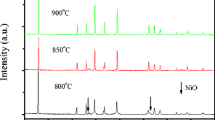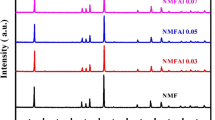Abstract
A new P2-structured oxide Na0.8Ni0.4Mn0.6O2 was synthesized using a solid reaction method in which Na2CO3, MnO2 and NiO were used as starting materials. This oxide has a high amount of electrochemically active Ni and exhibits good electrochemical intercalation behavior of Na ions, including good rate capability and good cycle performance at both room temperature and elevated temperature. It displays two apparent voltage plateaus at about 3.6 and 3.3 V, and its discharge capacity reaches 92 mAh·g−1 at 0.1C in the voltage range of 2.0–4.0 V. At 1.0C, its discharge capacity reaches 85.3 mAh·g−1. After 80 cycles at different current rates, the as-prepared sample exhibits good capacity retention. At elevated temperature of 55 °C, the discharge capacity remains the same at low current rate of 0.1C, but at high current rate of 1.0C, the discharge capacity is a little lower than that at room temperature.
Graphical Abstract
The first discharge capacity of the as-prepared Na/Na0.8Ni0.4Mn0.6O2 cell is about 158 mAh·g−1 at 0.1 C rate in the voltage range of 2.0–4.5 V. In the subsequent charge–discharge process, its discharge capacities are about 92 mAh·g−1 at 0.1C, 90 mAh·g−1 at 0.2C, 87.9 mAh·g−1 at 0.5C and 85.3 mAh·g−1 at 1.0C.








Similar content being viewed by others
References
Tamaru M, Wang XF, Okubo M. Layered Na2RuO3 as a cathode material for Na-ion batteries. Electrochem Commun. 2013;33:23.
Kim DH, Lee E, Slater M, Lu WQ, Rood S, Johnson CS. Layered Na[Ni1/3Fe1/3Mn1/3]O2 cathodes for Na-ion battery application. Electrochem Commun. 2012;18:66.
Billaud J, Clément RJ, Armstrong AR, Canales-vázquez J, Rozier P, Grey CP, Bruce PG. Beta-NaMnO2: a high-performance cathode for sodium-ion batteries. J Am Chem Soc. 2014;136(49):17243.
Wen YF, Wang B, Zeng G, Kazuhiro N, Ye DL, Wang LZ. Electrochemical and structural study of layered P2-type Na2/3Ni1/3Mn2/3O2 as cathode material for sodium-ion battery. Chem-Asian J. 2015;10(3):661.
Kubota K, Ikeuchi I, Nakayama T, Takei C, Yabuuchi N, Shiiba H, Nakayama M, Komaba S. New insight into structural evolution in layered NaCrO2 during electrochemical sodium extraction. J Phys Chem C. 2015;119(1):166.
Komaba S, Takei C, Nakayama T, Ogata A, Yabuuchi N. Electrochemical intercalation activity of layered NaCrO2 vs. LiCrO2. Electrochem Commun. 2010;12(3):355.
Guo H, Wang YS, Han WZ, Yu ZX, Qi XG, Sun K, Hu YS, Liu YT, Chen DF, Chen LQ. Na-deficient O3-type cathode material Na0.8[Ni0.3Co0.2Ti0.5]O2 for room-temperature sodium-ion batteries. Electrochim Acta. 2015;158:258.
Hosono E, Saito T, Hoshino J, Okubo M, Saito Y, Nishio-Hamane D, Kudo T, Zhou H. High power Na-ion rechargeable battery with single-crystalline Na0.44MnO2 nanowire electrode. J Power Sources. 2012;217:43.
Yoshida H, Yabuuchi N, Komaba S. NaFe0.5Co0.5O2 as high energy and power positive electrode for Na-ion batteries. Electrochem Commun. 2013;34:60.
Jian Z, Zhao L, Pan H, Hu YS, Li H, Chen W, Chen L. Carbon coated Na3V2(PO4)3 as novel electrode material for sodium ion batteries. Electrochem Commun. 2012;14(1):86.
Tripathi R, Wood SM, Islam MS, Nazar LF. Na-ion mobility in layered Na2FePO4F and olivine Na[Fe, Mn]PO4. Energ Environ Sci. 2013;6(8):2257.
Nose M, Nakayama H, Nobuhara K, Yamaguchi H, Nakanishi S, Iba H. Na4Co3(PO4)2P2O7: a novel storage material for sodium-ion batteries. J Power Sources. 2013;234:175.
Qian JF, Zhou M, Cao YL, Ai XP, Yang HX. Nanosized Na4Fe(CN)6/C composite as a low-cost and high-rate cathode material for sodium-ion batteries. Adv Energy Mater. 2012;2(4):410.
Wang SW, Wang LJ, Zhu ZQ, Hu Z, Zhao Q, Chen J. All organic sodium-ion batteries with Na4C8H2O6. Angew Chem Int Ed. 2014;53(23):5892.
Lu ZH, Dahn JR. In situ X-ray diffraction study of P2-Na2/3[Ni1/3Mn2/3]O2. J Electrochem Soc. 2001;148(11):A1225.
Wang H, Yang BJ, Liao XZ, Xu J, Yang DZ, He YS, Ma ZF. Electrochemical properties of P2-Na2/3[Ni1/3Mn2/3]O2 cathode material for sodium ion batteries when cycled in different voltage ranges. Electrochim Acta. 2013;113:200.
Liu GQ, Wen L, Li Y, Kou YL. Synthesis and electrochemical properties of P2-Na2/3Ni1/3Mn2/3O2. Ironics. 2015;21(4):1011.
Acknowledgments
This study was financially supported by the National Natural Science Foundation of China (No. 51574081) and the Natural Science Foundation of Liaoning Province (No. 2014020035).
Author information
Authors and Affiliations
Corresponding author
Rights and permissions
About this article
Cite this article
Liu, GQ., Li, Y., Du, YL. et al. Synthesis and properties of Na0.8Ni0.4Mn0.6O2 oxide used as cathode material for sodium ion batteries. Rare Met. 36, 977–980 (2017). https://doi.org/10.1007/s12598-016-0757-9
Received:
Revised:
Accepted:
Published:
Issue Date:
DOI: https://doi.org/10.1007/s12598-016-0757-9




